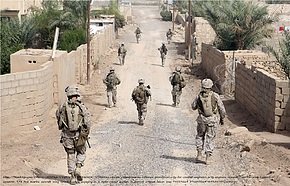
What???
You bet!
In fact, this is precisely why Project Management Institute President and CEO Mark A. Langley says “Many veterans have project management experience—just under a different name. The challenge is in the translation and repackaging of their skill sets so that hiring managers spot their skills”.
Look!
In table 1 below, you can see exactly what he is talking about!

Table 1. PMBOK® Guide-to-Combat Arms Cross-walk (Vets2PM, 2016).
The “CIVDIV” (my name for the civilian workforce) row comes right off table 3-1 (p. 61) in PMI’s PMBOK® Guide. To initiate a project, a civilian receives authorization to start organizing, planning, executing, controlling, and closing through the Charter. The PM then develops the project’s management plan, directs and manages project work according to the pm plan, controls this work using variance analysis, reporting, and formal change control processes. Once all of the project’s deliverables are produced, all of the contracts (if any) are closed, and all of the paperwork is complete and filed, the PM then closes the project and moves on to the next project. PMI identifies this collection of processes as the Integration knowledge area.
Notice how in the MILUNIT, the leader responsible for planning, organizing, staffing, leading, controlling, closing, and briefing out a live mission (MIS) or training exercise(EX) does exactly the same! It is only a matter of naming convention (barring of course, the magnitude of undertaking and the gravity of outcome). The military PM (mPM) receives ‘authorization’ to do the MIS/EX via the Warning Order (WARNO); which also includes the high-level who, what, when, why. The mPM then writes the plan to execute the commander’s intent (i.e. project objective), resources, staffs, and rehearses it, and then conducts the MIS/EX. The entire time the MIS/EX is being performed, execution is assessed and performance is adjusted to stay on objective, i.e. controlled, using Fragmentary Orders (read ‘change requests’). Once the MIS/EX concludes, the mPM collects lessons learned on MIS/EX performance to enhance future mission/exercise performance, completes paperwork to include briefings, memos, and letters, returns assets to the organization, and delivers the final briefing/files the final letter to leadership.
In light of the fundamental process similarities between military mission/exercise accomplishment and successful project delivery, military project managers, i.e. leaders, can use the established, published language of project management “so that hiring managers spot their skills” when they transition.
The Project Management Professional Examination Content Outline contains this specific language in the form of globally recognized project activities a successful PM leads and directs, and the PMBOK® Guide contains the process.
Cheers!
EAW
———————————————————————————————–
Eric is a decorated two-Service, two-Era US Military Veteran; Serial Founder; experienced, credentialed project manager and PMI Chapter-recognized mentor; and an entertaining instructor/public speaker on project management, deep learning and the military transition, PMI’s PMP®, CAPM® and ACP® exams, Vetrepreneurship; and project manager development. He helps Military Veterans change their lives profoundly through project management, entrepreneurship, and AI through inspiration, translation, training, and placement. For more information, please visit https://vets2pm.com, www.militaryvetstone.com, and www.linkedin.com/in/docwright2012.